 |

O L D W O R L D E N C O U N T E R S
Civilizations in Dialogue before the Modern Era
B R I E F S Y L L A B U S |
| UNIT 01 |
HERODOTUS AUTHOR'S CONTEXT
author: Herodotus of Halicarnassus
when: ca.484-420 BCE
where: Halicarnassus > Athens > Thurii
context/summary: born in a Dorian city under the Persian yoke; composed for an Ionian (Athenian) elite; oral tales organized into the "first" history, at time of Peloponnesian War
NARRATIVE CONTEXT
title: Historia (“Inquiry”)
when: ca.480 BCE
who: Cyrus, Darius, Xerxes, etc.; varied ethnic groups
where: ecumene (i.e. the "inhabited world" as known by the Greeks)
context/summary: opposion of Hellenes ("Greeks") vs barbaroi ("oogah-boogahs") in diametrical opposition and symmetrical balance; cultural relativism (changeable nomos vs unchanging physis); violent men overstepping boundaries (hybris) will get their comeuppance (nemesis) |
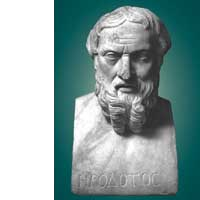 |
Herodotus of Halicarnassus
Historia (The Inquiry)
ch.1 Lydia, Persia, etc. (ch.1.1-5, 93-94, 131-40, 192-200, 214-16)
ch.2 Egypt (ch.2 entire, 3.11-12)
ch.3 Ethiopia, India, Arabia (3.20-24, 98-117)
revolt (ch.3.79-89)
Behistun
AUTHOR'S CONTEXT
author: Old Persian, Elamite and Akkadian scribes
when: ca.500 BCE
where: Behistun (mod. Bīsutūn)
context: gods as audience (setting hundreds of meters up a cliff face)
NARRATIVE CONTEXT
title: DB (Darius, Behistun) - Behistun Inscription
when: ca.520 BCE
who: Darius vs Smerdis, Ahuramazda vs The Lie, the magi
where: Persian Empire
context/summary: usurper Darius claims legitimacy (DB);
Darius Statue
AUTHOR'S CONTEXT
author: Old Persian & Egyptian scribes
when: ca.500 BCE
where: Susa
context: dedication by Egyptian craftsman to Persian emperor
NARRATIVE CONTEXT
title: DSab (Darius, Susa, Egyptian text a, Persian text b) - Darius Statue
when: ca.520 BCE
who: Darius
where: Persian Empire
context/summary: peoples of the empire (with ethnic names in cartouches) legitimizing and supporting the (usurper) king
(DSab)
ch.4 Scythia, Libya (ch.4, entire); Thrace (5.3-8)
ch.5-9 Persian War (skim ch.3.89-105, 7.61-99)
THEMES folklore motifs, ethnography; Ionian Enlightenment
COMPARE MegasthenesAUTHOR'S CONTEXT
author: Megasthenes
when: ca.350-290 BCE
where: Asia Minor (mod. Turkey)
context/summary: born in Late Classical Period; served as ambassador to India for Seleucus I Nicator, the immediate successor (diadochus) of Alexander III Megas ("the Great"), within one generation after the conquest of the Persian Empire
NARRATIVE CONTEXT
title: Indika (“On India”)
when: ca.300 BCE
who: Chandragupta (reigned ca.321–297 BCE) founder of the Mauryan Dynasty and grandfather of Aśoka (reigned ca.268-232 BCE); various ethnic groups and castes; various customs and animals
where: river basins of the Indus and Ganges
context/summary: opposion of Hellenes ("Greeks") vs barbaroi ("oogah-boogahs") in diametrical opposition and symmetrical balance; cultural relativism (changeable nomos vs unchanging physis) Indika (On India, ca.300 BCE) |
| UNIT 02 |
XUANZANG AUTHOR'S CONTEXT
author: Xuanzang
when: ca.602-664 CE
where: Chang'an (mod. Xi'an)
context/summary: born in Luoyang (Henan) at the end of the Sui dynasty; ordained as a Buddhist priest in Chengdu (Sichuan); enjoyed the patronage of the Tang dynasty emperor Taizong
NARRATIVE CONTEXT
title: Siyu ki (“Records of Regions to the West”)
when: ca.630-645 CE
who: supported by Harsha of Kanauj (aka Kumara-raja, aka Shiladitya-raja), of the Vardhana dynasty, and Bhaskaravarma of Kamarupa (also Kumara-raja “king's son”), a vassal of Harsha, ca.660-650 CE; also supported by Avalokiteshvara-bodhisattva his divine guardian
where: various South Asian Buddist reliquaries (stupas) and monasteries (sangaramas), particularly the Nalanda Monastery (Mahavihara), primary center of Mahayana Buddhist learning
context/summary: opposion of raw vs cooked, Buddhist cosmology with Lake Anavatapta at the center of the ecumene (Jambudvipa), with four rivers leading in the four cardinal directions to the Land of Men (China), Land of Horses (Eurasian steppe), the Land of Gems (Afghanistan) and the Land of Elephants (India) |
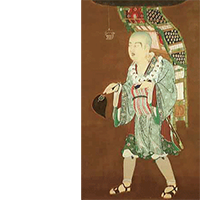 |
Xuanzang of Luozhou
Xiyu ji (Records of Regions to the West)
ch.1-2 (Turkestan; Customs of India)
ch.3-4 (Northern India, I)
ch.5-6 (Magadha)
ch.7-8 (Northern India, I)
ch.9-10 (East Coast)
ch.11-12 (West Coast)
THEMES imperialism; pilgrimage; Buddhism
COMPARE EgeriaAUTHOR'S CONTEXT
author: Egeria (Etheria, or Aetheria)
when: ca.380 CE
where: Iberia (Spain)? Gaul (France)?
context/summary: rare instance of a letter written by a woman (a nun?), for women (a convent?), about pilgrimage to Jerusalem; composed during the reign of Theodosius I
NARRATIVE CONTEXT
title: Perigrinatio (“pilgrimage”), or Itinerarium (“itinerary”)
when: ca.380 CE
who: Jesus of Nazareth
where: Jerusalem, or Holy Lands (Mt. Sinai to Constantinople); liturgical worship; Lent, Palm Sunday, Easter holy days
context/summary: Itinerarium (Pilgrimage, ca.380 CE)
ESSAY 01
|
| UNIT 03 |
AL-BIRUNI AUTHOR'S CONTEXT
author: Abū Rayḥān Muḥammad ibn Aḥmad al-Bīrūnī
when: ca.973-1050 CE
where: Khwarizm (or Kiva) > Ghazna (mod. Ġaznī)
context/summary: native Persian speaking scholar, fluent in Arabic, Greek and Hebrew; impressed into the service of Ghaznavid ruler Maḥmūd
NARRATIVE CONTEXT
title: Kitab al-Hind (“On India”), or
Taḥqīq mā li-l-hind min maqūlah maqbūlah fī al-ʿaql aw mardhūlah
(“Verifying All That the Indians Recount, the Reasonable and the Unreasonable”)
when: ca.1040 CE
who: supported by Maḥmūd of Ghazna (ca.970-1030 CE), then his son and successor, Mas'ud (ca.1030-1040 CE)
where: Indus River basin centers of Hindu learning
context/summary: opposition of Hinduism and Islam; cosmology and cosmogony; science |
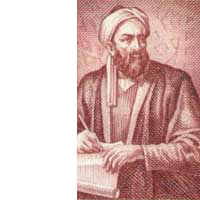 |
Abu Rayhan al-Biruni of Khwarizm
Kitab al-Hind (On India)
1 (Introduction)
2-11 (Religion, Philosophy, etc.)
12-17 (Literature, Metrology, Usages, etc.)
18-31 (Geography, Cosmography, Astronomy, etc.)
32-62 (Chronology, Astronomy, etc.)
63-79 (Manners, Customs, etc.)
80 (Astrology)
THEMES crusade; science/medicine; Hinduism
COMPARE Ibn MunqidhAUTHOR'S CONTEXT
author: Majd al-Dīn Usāma ibn Murshid ibn ʿAlī ibn Munqidh al-Kināni al-Kalbi
when: 1095-1188 CE
where: Shaizar (Gk. Larissa, mod. Saijar or Šaizar) > Mosul > Damascus > Cairo
context/summary: born at the time of the First Crusade (1095-1099 CE); served as a faris (“knight”) under the rulers of Mosul, Damascus and Cairo, through the Second Crusade (1147-1150 CE) and later back to Damascus under Sala al-Din (reigned 1174-1193 CE), who eventually retook Jerusalem.
NARRATIVE CONTEXT
title: Kitab al-I‘tbar (“Contemplations”)
when: ca.1183 CE
who: dedicated to Sala al-Din
where: Levant, or al-Šam (i.e. Syria, including Lebanon, Israel, Palestine)
context/summary: diametrical opposition of Arabs vs Franks (i.e. Europeans); cultural relativism Kitab al-I‘tbar (Contemplations, 1183 CE)
|
| UNIT 04 |
IBN BATTUTA AUTHOR'S CONTEXT
author: Ibn Battuta, or ʾAbū ʿAbd al-Lāh Muḥammad ibn ʿAbd al-Lāh al-Lawātī al-Ṭanǧī ibn Baṭūṭah
when: ca.1304-1369 CE
where: Tangier (mod. Ṭanǧa), Morocco (al-Maghrib)
context/summary: Arabic speaking Berber, legal scholar (qadi) of the Maliki school of jurisprudence; took advantage of the pax Mogolica to travel much of the known (Islamic) world
NARRATIVE CONTEXT
title: Riḥlat (“Travels”), subtitled
Tuḥfat an-Nuẓẓār fī Gharāʾib al-Amṣār wa ʿAjāʾib al-Asfār
(“A Gift to Those Who Contemplate the Wonders of Cities and the Marvels of Travelling”), as dictated to Muhammad ibn Ahmad ibn Juzayy al-Kalbi al-Gharnati
when: ca.1355 CE
who: numerous rulers and territories, including those he called the "seven mighty" rulers: Abu Inan Faris, the Marinid sultan of Morocco; Al-Malik al-Nasir, Mamluk sultan of Egypt and Syria; Abu Sa“id, khan of the Two Iraqs (Il-khanate); Ozbeg-khan of the Qipchaq khanate (the steppe); Tarmashirin-khan of Chagatai khanate (Turkestan); Muhammad bin Tughluq, sultan of Dehli (India); and Toghon Temür of the Yuan khanate (China).
where: the entire known Islamic world
context/summary: opposition of the community of Islam (ummah) vs other peoples of the Book (dhimmah); orthodox Sunni vs other sects (e.g. Shia, Nusayri/Alawi); the Malaki school vs other legal schools; etc. |
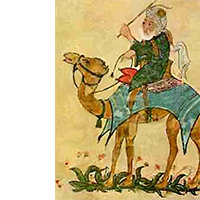 |
Abu Abdullah Muhammad Ibn Battuta of Tangiers
Rihla (Travels)
ch.1-3. North-West Africa, Egypt, Syria
ch.4-6. Hijaz, Persia, Iraq
ch.7-9. Yemen, Asia Minor, South Russia, Turkestan
ch.10-14. Northern India
ch.15-19 Southern India, Maldives, Malabar
ch.20-23 South Asia, China
ch.24-25 Spain and Mali
THEMES travelogue; law; Islam
COMPARE Ibn FadlanAUTHOR'S CONTEXT
author: Aḥmad ibn Faḍlān ibn al-ʿAbbās ibn Rāšid ibn Ḥammād
when: ca.880-960 CE
where: uncertain origins > Baghdad > Volga River > Baghdad
context/summary: legal scholar (qadi) in the court of the Abbasid caliph Al-Muqtadir (908-932 CE)
NARRATIVE CONTEXT
title: Risala (“Journal”)
when: 921 CE
who: iltabar (vassal) of Khazars; Bulgars; Rus
where: Volga River basin (mod. Ukraine)
context/summary: diametrical opposition of Arabs vs Rus (i.e. Vikings); cultural relativism Risala (Journal, ca.920 CE)
ESSAY 02
|
| UNIT 05 |
ÁLVARES AUTHOR'S CONTEXT
author: Francisco Álvares, S.J.
when: ca.1465-1541 CE
where: Coimbra (Portugal) > Lisboa
context/summary: priest of the Society of Jesus (or Jesuit order); member of embassy sent by Manuel I of Portugal to Abyssinia, specializing in canon law (legal scholar); joined by Armenian Matheus, ambassador from Eleni of Abyssinia to Manuel; witness to tensions between the ambassador, Dom Rodrigo, and his second, Jorge d'Abreu; opening of sea-route to India in age of exploration
NARRATIVE CONTEXT
title: Verdadeira Informação das Terras do Preste João das Indias ("A True Relation of the Lands of Prester John of the Indies")
when: ca.1520-27 CE
who: Álvares, Dom Rodrigo, Matheus, Eleni, Lebna Degnal (Prester John)
where: Abyssinia (mod. Eritrea and Ethiopia); Massawa, Axum/Adua, Lalibela
context/summary: opposition of Roman Catholic and Ethiopian Orthodox (Coptic Christian); language, religion and customs of Abyssinians; political organization |
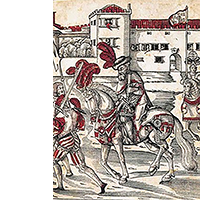 |
Francisco Álvares S.J. of Coimbra
Preste João das Indias (Prester John of the Indes)
ch.1-20
ch.21-40
ch.41-60
ch.61-80
ch.81-100
ch.101-120
ch.121-140
THEMES colonialism; Christianity
|
|
FINAL EXAM
ESSAY 03 |
|
|